Synthesis and Characterization of Zeolites Produced from Low-Quality Coal Fly Ash and Wet Flue Gas Desulphurization Wastewater
Abstract
1. Introduction
2. Materials
2.1. Fly Ash
2.2. Wastewater from the WFGD Process
2.3. Clinoptilolite and Zeolite Na–P1
2.4. Methodology of Synthesis
2.4.1. First stage of the experiment
2.4.2. Second Stage of the Experiment
3. Analytical Methods
3.1. XRD and XRF
3.2. Textural Analysis
3.3. Multi-Element Sorption Experiments
- 1 mg Cd(II)/L + 1 mg Ni(II)/L + 1 mg Se(VI)/L + 100 mg NH4+/L; initial pH of solution (pHin) = 6;
- 2 mg Cd(II)/L + 2 mg Ni(II)/L + 2 mg Se(VI)/L + 200 mg NH4+/L; pHin = 5.96; and;
- 5 mg Cd(II)/L + 5 mg Ni(II)/L + 5 mg Se(VI)/L + 300 mg NH4+/L; pHin = 5.81.
4. Results and Discussion
4.1. Phase and Chemical Analysis
4.2. Textural Characteristics
5. Conclusions
Author Contributions
Funding
Institutional Review Board Statement
Informed Consent Statement
Data Availability Statement
Conflicts of Interest
Abbreviations
References
- Jha, B.; Singh, D.N. A review on synthesis, characterization and industrial applications of fly ash zeolites. J. Mater. Educ. 2011, 33, 65–132. [Google Scholar]
- Weckhuysen, B.M.; Yu, J. Recent advances in zeolite chemistry and catalysis. Chem. Soc. Rev. 2015, 44, 7022–7024. [Google Scholar] [CrossRef] [PubMed]
- Armbruster, T.; Gunter, M.E. Crystal structure of natural zeolites. Rev. Min. Geochem. 2001, 45, 1–68. [Google Scholar] [CrossRef]
- Erdem, E.; Karapinar, N.; Donat, R. The removal of heavy metal cations by natural zeolites. J. Colloid Interface Sci. 2004, 280, 309–314. [Google Scholar] [CrossRef] [PubMed]
- Misaelides, P. Application of natural zeolites in environmental remediation: A short review. Microporous Mesoporous Mater. 2011, 144, 15–18. [Google Scholar] [CrossRef]
- Ghasemi, Z.; Sourinejad, I.; Kazemian, H.; Rohani, S. Application of zeolites in aquaculture industry: A review. Rev. Aquac. 2018, 10, 75–95. [Google Scholar] [CrossRef]
- Moshoeshoe, M.; Nadiye-Tabbiruka, M.S.; Obuseng, V. A Review of the Chemistry, Structure, Properties and Applications of Zeolites. Am. J. Mater. Sci. 2017, 7, 196–221. [Google Scholar]
- Nakhli, S.A.A.; Delkash, M.; Bakhshayesh, B.E.; Kazemian, H. Application of Zeolites for Sustainable Agriculture: A Review on Water and Nutrient Retention. Water Air Soil Pollut. 2017, 228, 464–498. [Google Scholar] [CrossRef]
- Bacakova, L.; Vandrovcova, M.; Kopova, I.; Jirka, I. Applications of zeolites in biotechnology and medicine—A review. Biomater. Sci. 2018, 6, 974–989. [Google Scholar] [CrossRef]
- Franus, W. Characterization of X-type Zeolite Prepared from Coal Fly Ash. Pol. J. Environ. Stud. 2012, 21, 337–343. [Google Scholar]
- Wdowin, M.; Franus, M.; Panek, R.; Bandura, L.; Franus, W. The conversion technology of fly ash into zeolites. Clean Technol. Environ. Policy 2014, 16, 1217–1223. [Google Scholar] [CrossRef]
- Breeze, P. Coal-Fired Generation; Academic Press: Cambridge, MA, USA, 2015. [Google Scholar]
- Belviso, C. State-of-the art applications of fly ash from coal and biomass: A focus on zeolite synthesis processes and issues. Prog. Energy Combust. Sci. 2018, 65, 109–135. [Google Scholar] [CrossRef]
- Giergiczny, Z. Fly ash and slag. Cem. Concr. Res. 2019, 124, 105826. [Google Scholar] [CrossRef]
- Kazemian, H.; Naghdali, Z.; Ghaffari Kashani, T.; Farhadi, F. Conversion of high silicon fly ash to NaP1 zeolite: Alkaline fusion followed by hydrothermal crystallization. Adv. Powder Technol. 2010, 21, 279–283. [Google Scholar] [CrossRef]
- Franus, W.; Wdowin, M.; Franus, M. Synthesis and characterization of zeolites prepared from industrial fly ash. Environ. Monit. Assess. 2014, 186, 5721–5729. [Google Scholar] [CrossRef]
- Wałek, T.T.; Saito, F.; Zhang, Q. The Effect of Low Solid/Liquid Ratio on Hydrothermal Synthesis of Zeolites from Fly Ash. Fuel 2008, 87, 3194–3199. [Google Scholar] [CrossRef]
- Inada, M.; Tsujimoto, H.; Eguchi, Y.; Enomoto, N.; Hojo, J. Microwave-assisted zeolite synthesis from coal fly ash in hydrothermal process. Fuel 2005, 84, 1482–1486. [Google Scholar] [CrossRef]
- Adamczyk, Z.; Białecka, B. Hydrothermal Synthesis of Zeolites from Polish Coal Fly Ash. Pol. J. Environ. Stud. 2005, 14, 713–719. [Google Scholar]
- Musyoka, N.M.; Petrik, L.F.; Fatoba, O.O.; Hums, E. Synthesis of zeolites from coal fly ash using mine waters. Miner. Eng. 2013, 53, 9–15. [Google Scholar] [CrossRef]
- Yao, Z.T.; Ji, X.S.; Sarker, P.K.; Tang, J.H.; Ge, L.Q.; Xia, M.S.; Xi, Y.Q. A comprehensive review on the application of coal fly ash. Earth-Sci. Rev. 2015, 141, 105–121. [Google Scholar] [CrossRef]
- Łaskawiec, K.; Gębarowski, P.; Kramek-Romanowska, K. Effect of de-NOx technologies employed in thermal power plants on fly ash propertie. Acta Energetica 2016, 29, 58–63. [Google Scholar] [CrossRef]
- Brännvall, E.; Kumpiene, J. Fly ash in landfill top covers—A review. Environ. Sci. Process. Impacts 2016, 18, 11–21. [Google Scholar] [CrossRef]
- Huang, T.; Chiueh, P.T.; Lo, S.L. Life-cycle environmental and cost impacts of reusing fly ash. Resour. Conserv. Recycl. 2017, 123, 255–260. [Google Scholar] [CrossRef]
- Blissett, R.S.; Rowson, N.A. A review of the multi-component utilization of coal fly ash. Fuel 2012, 97, 1–23. [Google Scholar] [CrossRef]
- Lottermoser, B.G. Recycling, Reuse and Rehabilitation of Mine Wastes. Elements 2011, 7, 405–410. [Google Scholar] [CrossRef]
- Poullikkas, A. Review of Design, Operating, and Financial Considerations in Flue Gas Desulfurization Systems. Energy Technol. Policy 2015, 2, 92–103. [Google Scholar] [CrossRef]
- Anjum, M.; Al-Makishah, N.; Barakat, M.A. Wastewater sludge stabilization using pre-treatment methods. Process. Saf. Environ. Prot. 2016, 102, 615–632. [Google Scholar] [CrossRef]
- Koralegedara, N.H.; Pinto, P.X.; Dionysiou, D.D.; Al-Abded, S.R. Recent advances in flue gas desulfurization gypsum processes and applications—A review. J. Environ. Manag. 2019, 251, 109572. [Google Scholar] [CrossRef]
- Cordoba, P.; Staicu, L.C. Flue gas desulfurization effluents: An unexploited selenium resource. Fuel 2018, 223, 268–276. [Google Scholar] [CrossRef]
- Abdel-Shafy, H.I.; Mansour, M.S.M. Solid waste issue: Sources, composition, disposal, recycling, and valorization. Egypt. J. Pet. 2018, 27, 1275–1290. [Google Scholar] [CrossRef]
- Wołowiec, M.; Muir, B.; Zięba, K.; Bajda, T.; Kowalik, M.; Franus, W. Experimental Study on the Removal of VOCs and PAHs by Zeolites and Surfactant-Modified Zeolites. Energy Fuels 2017, 31, 8803–8812. [Google Scholar] [CrossRef]
- Bandura, L.; Franus, M.; Józefaciuk, G.; Franus, W. Synthetic zeolites from fly ash as effective mineral sorbents for land-based petroleum spills cleanup. Fuel 2015, 147, 100–107. [Google Scholar] [CrossRef]
- Szala, B.; Bajda, T.; Matusik, J.; Zięba, B.; Kijak, B. BTX sorption on Na-P1 organo-zeolite as a process controlled by the amount of adsorbed HDTMA. Microporous Mesoporous Mater. 2015, 202, 115–123. [Google Scholar] [CrossRef]
- Ter-Minassian-Saraga, L. Reporting experimental pressure-area data with film balances (Recommendations 1984). Pure Appl. Chem. 1985, 57, 621–632. [Google Scholar] [CrossRef]
- Rouquerol, F.; Rouquerol, J.; Sing, K. Adsorption by Powders and Porous Solids, Principles, Methodology and Application; Academic Press: London, UK, 1998. [Google Scholar]
- Muir, B.; Matusik, J.; Bajda, T. New insights into alkylammonium-functionalized clinoptilolite and Na-P1 zeolite: Structural and textural features. Appl. Surf. Sci. 2016, 361, 242–250. [Google Scholar] [CrossRef]
- Bergmann, J.; Friedel, P.; Kleeberg, R. BGMN—A new fundamental parameters based Rietveld program for laboratory Xray sources, it’s use in quantitative analysis and structure investigations. Int. Union Crystallogr. CPD Newslett. 1998, 20, 5–8. [Google Scholar]
- Gillman, G.P.; Sumpter, E.A. Modification to the compulsive exchange method for measuring exchange characteristics of soils. Aust. J. Soil Res. 1986, 24, 61–66. [Google Scholar] [CrossRef]
- Brunauer, S.; Emmett, P.H.; Teller, E. Adsorption of gases in multimolecular layers. J. Am. Chem. Soc. 1938, 60, 309–319. [Google Scholar] [CrossRef]
- Dubinin, M.M. The potential theory of adsorption of gases and vapors for adsorbents with energetically nonuniform surfaces. Chem. Rev. 1960, 60, 235–241. [Google Scholar] [CrossRef]
- Barrett, E.P.; Joyner, L.G.; Halenda, P.P. The Determination of Pore Volume and Area Distributions in Porous Substances. I. Computations from Nitrogen Isotherms. J. Am. Chem. Soc. 1951, 73, 373–380. [Google Scholar] [CrossRef]
- Thompson, J.; Morrison, G. Determination of Organic Nitrogen. Control of Variables in the Use of Nessler’s Reagent. Anal. Chem. 1951, 23, 1153–1157. [Google Scholar] [CrossRef]
- Cundy, C.S.; Cox, P.A. The hydrothermal synthesis of zeolites: Precursors, intermediates and reaction mechanism. Microporous Mesoporous Mater. 2005, 82, 1–78. [Google Scholar] [CrossRef]
- Czuma, N.; Baran, P.; Franus, W.; Zabierowski, P.; Zarębska, K. Synthesis of zeolites from fly ash with the use of modified two-step hydrothermal method and preliminary SO2 sorption tests. Adsorpt. Sci. Technol. 2019, 37, 61–76. [Google Scholar] [CrossRef]
- Derkowski, A.; Franus, W.; Waniak-Nowicka, H.; Czímerová, A. Textural properties vs. CEC and EGME retention of Na–X zeolite prepared from fly ash at room temperature. Int. J. Miner. Process. 2007, 82, 57–68. [Google Scholar] [CrossRef]
- De Rossi, A.; Simão, L.; Ribeiro, M.J.; Novais, R.M.; Labrincha, J.A.; Hotza, D.; Moreira, R.F.P.M. In-situ synthesis of zeolites by geopolymerization of biomass fly ash and metakaolin. Mater. Lett. 2019, 236, 644–648. [Google Scholar] [CrossRef]
- Belviso, C.; Cavalcante, F.; Fiore, S. Synthesis of zeolite from Italian coal fly ash: Differences in crystallization temperature using seawater instead of distilled water. Waste Manag. 2010, 30, 839–847. [Google Scholar] [CrossRef]
- Brassell, J.P.; Ojumu, T.W.; Petrik, L.F. Upscaling of Zeolite Synthesis from Coal Fly Ash Waste: Current Status and Future Outlook. Chapter 1. In Zeolites—Useful Minerals; Belviso, C., Ed.; IntechOpen: London, UK, 2016. [Google Scholar] [CrossRef][Green Version]
- Bandura, L.; Panek, R.; Rotko, M.; Franus, W. Synthetic zeolites from fly ash for an effective trapping of BTX in gas stream. Microporous Mesoporous Mater. 2015, 223, 1–9. [Google Scholar] [CrossRef]
- Naumov, S. Hysteresis Phenomena in Mesoporous Materials. Ph.D. Thesis, Universität Leipzig, Leipzig, Germany, 2009. [Google Scholar]
- Maziarz, P.; Matusik, J.; Radziszewska, A. Halloysite-zero-valent iron nanocomposites for removal of Pb(II)/Cd(II) and As(V)/Cr(VI): Competitive effects, regeneration possibilities and mechanisms. J. Environ. Chem. Eng. 2019, 7, 103507. [Google Scholar] [CrossRef]
- Brookins, D.G. Eh-PH Diagrams for Geochemistry; Springer: Berlin, Germany, 1988. [Google Scholar]
- Widiastuti, N.; Wu, H.; Ang, H.M.; Zhang, D. Removal of ammonium from greywater using natural zeolite. Desalination 2011, 277, 15–23. [Google Scholar] [CrossRef]
- Munthali, M.W.; Elsheikh, M.A.; Johan, E.; Matsue, N. Proton Adsorption Selectivity of Zeolites in Aqueous Media: Effect of Si/Al Ratio of Zeolites. Molecules 2014, 19, 20468–20481. [Google Scholar] [CrossRef]
- Olin, Å.; Noläng, B.; Osadchii, E.G.; Öhman, L.; Rosén, E. Chemical Thermodynamics of Selenium; Elsevier Science: Amsterdam, The Netherlands, 2005. [Google Scholar]
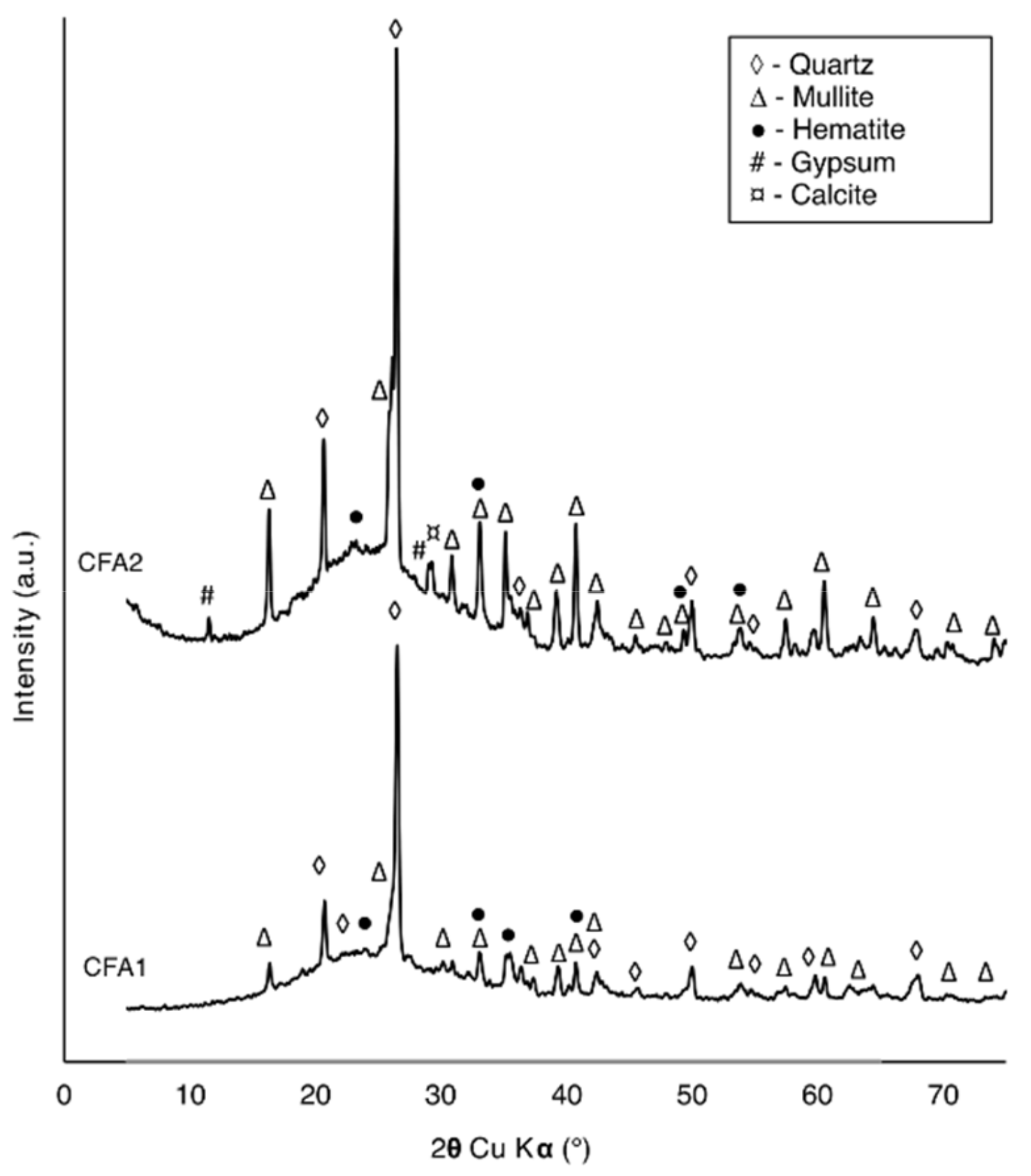
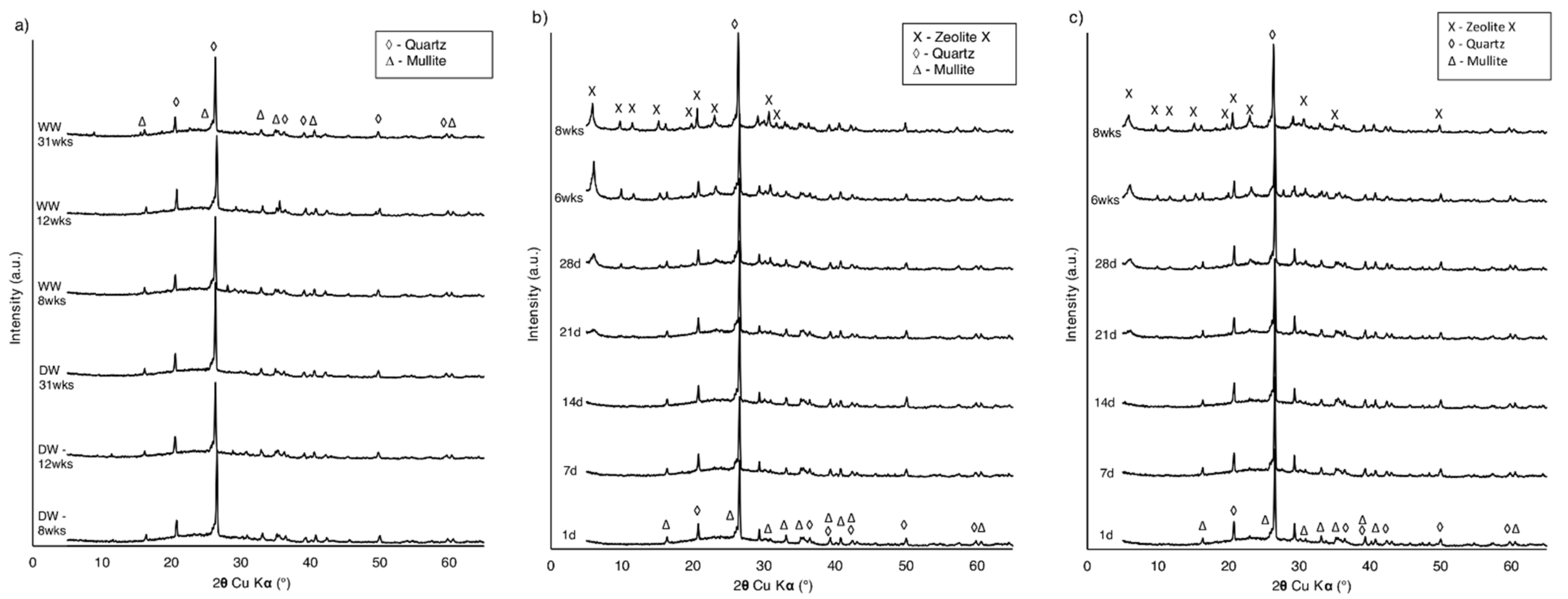
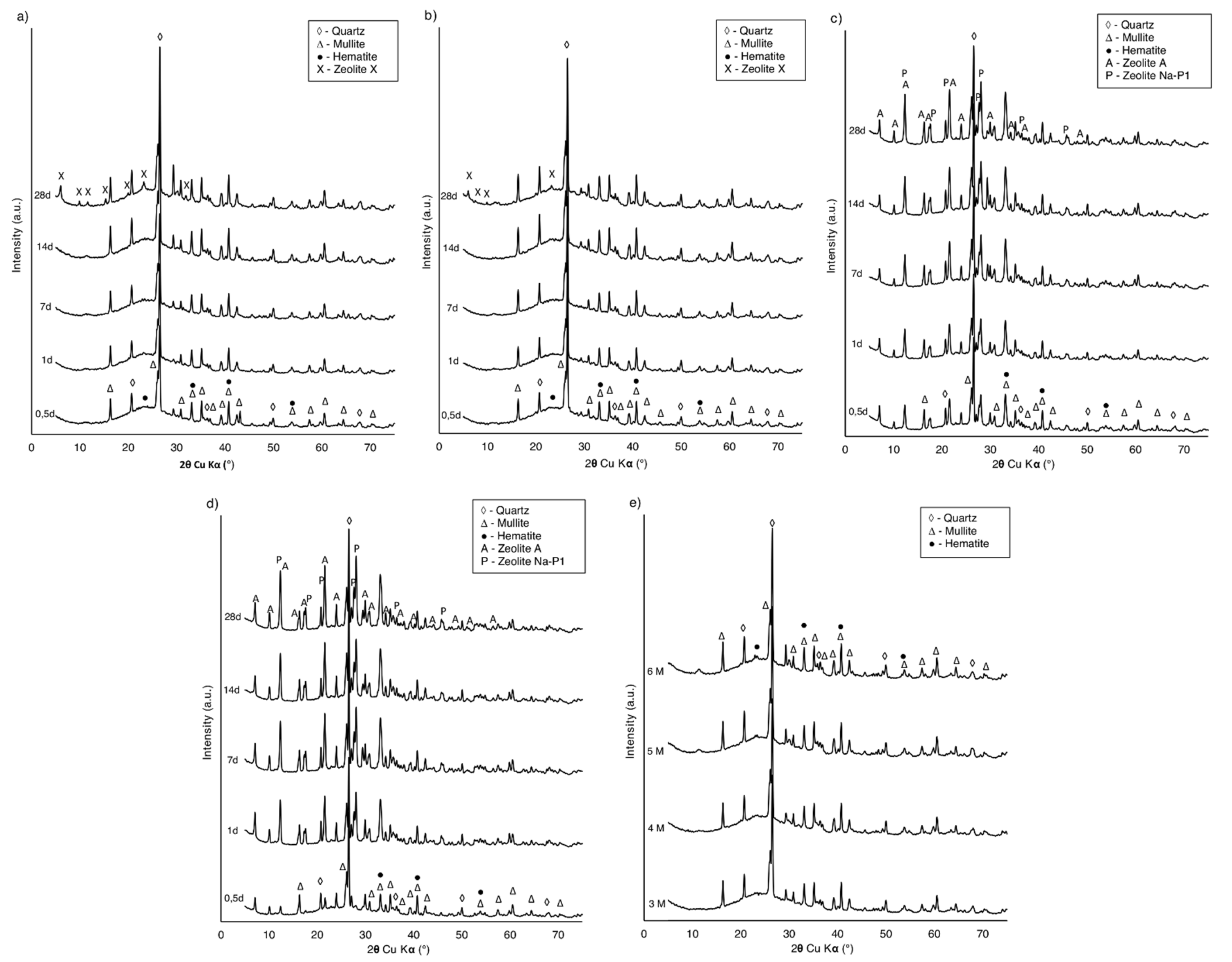
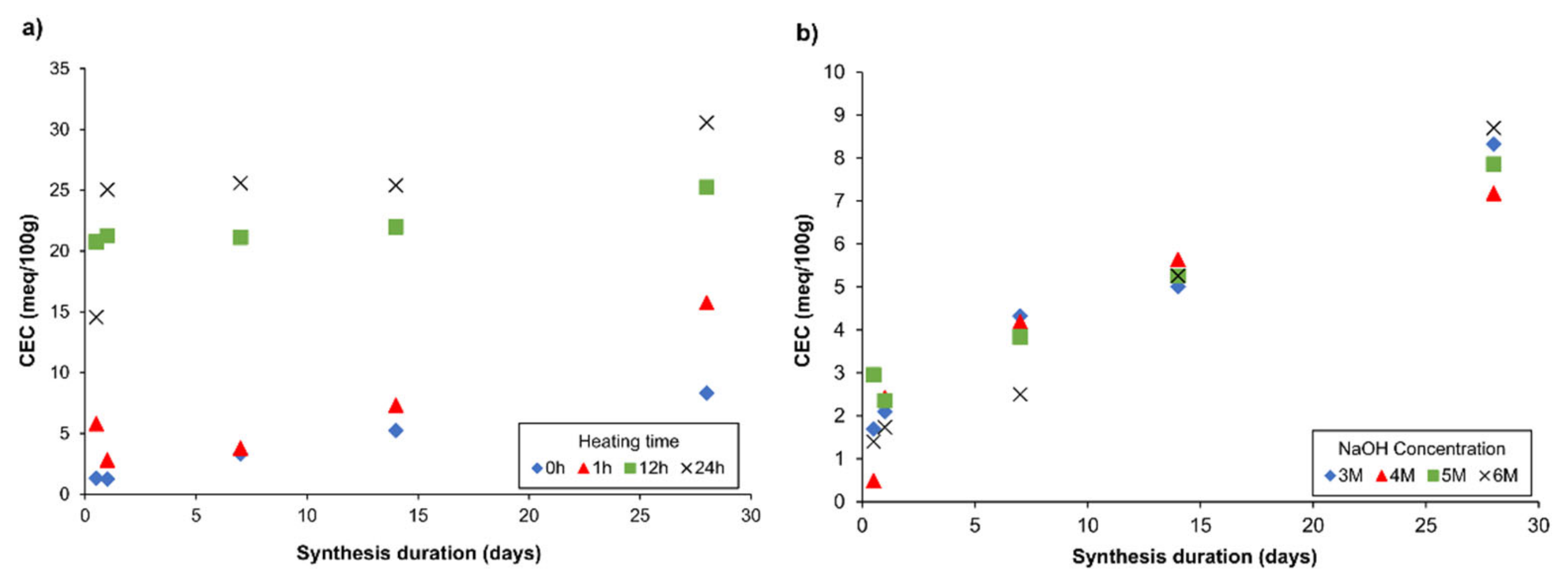
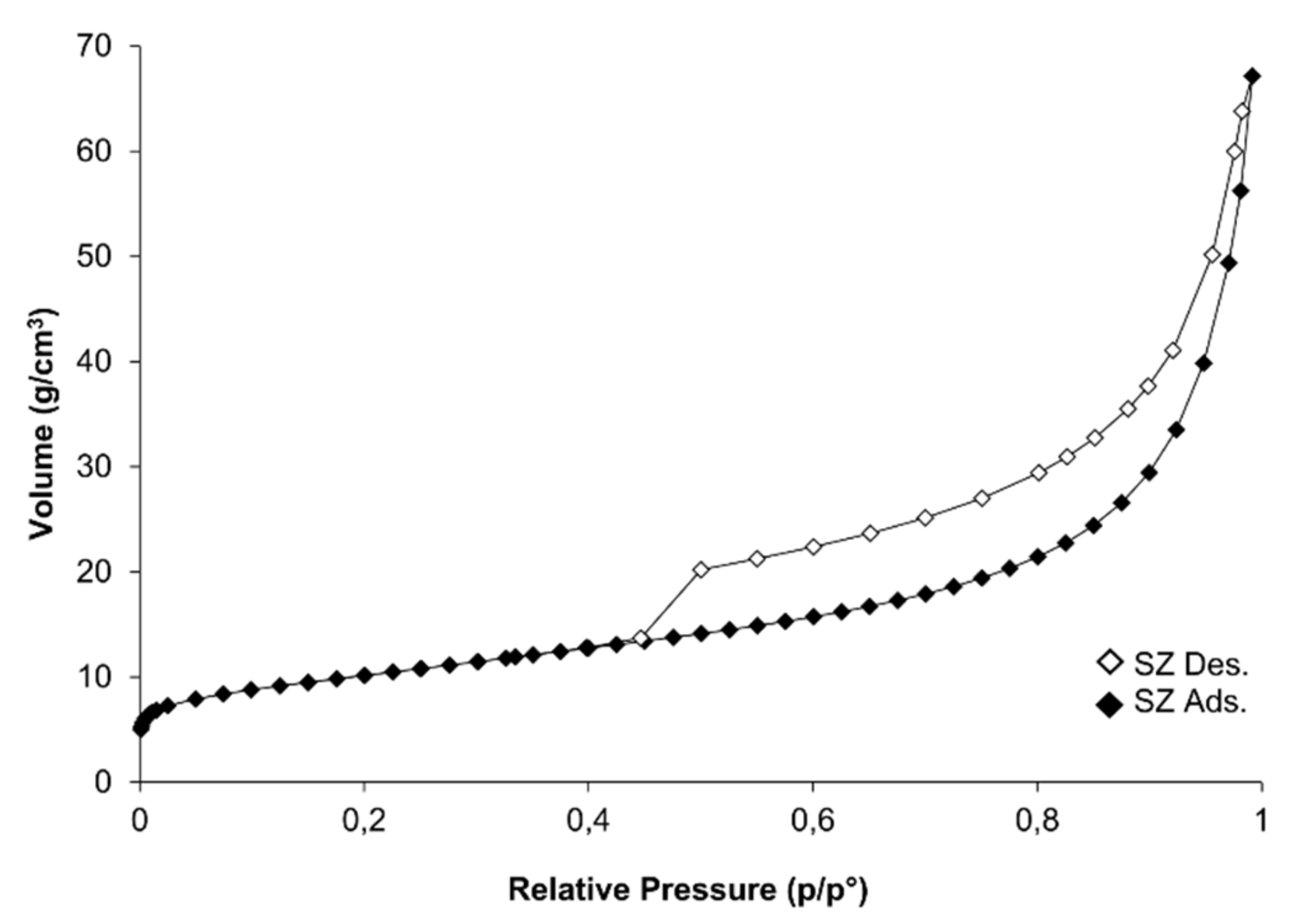

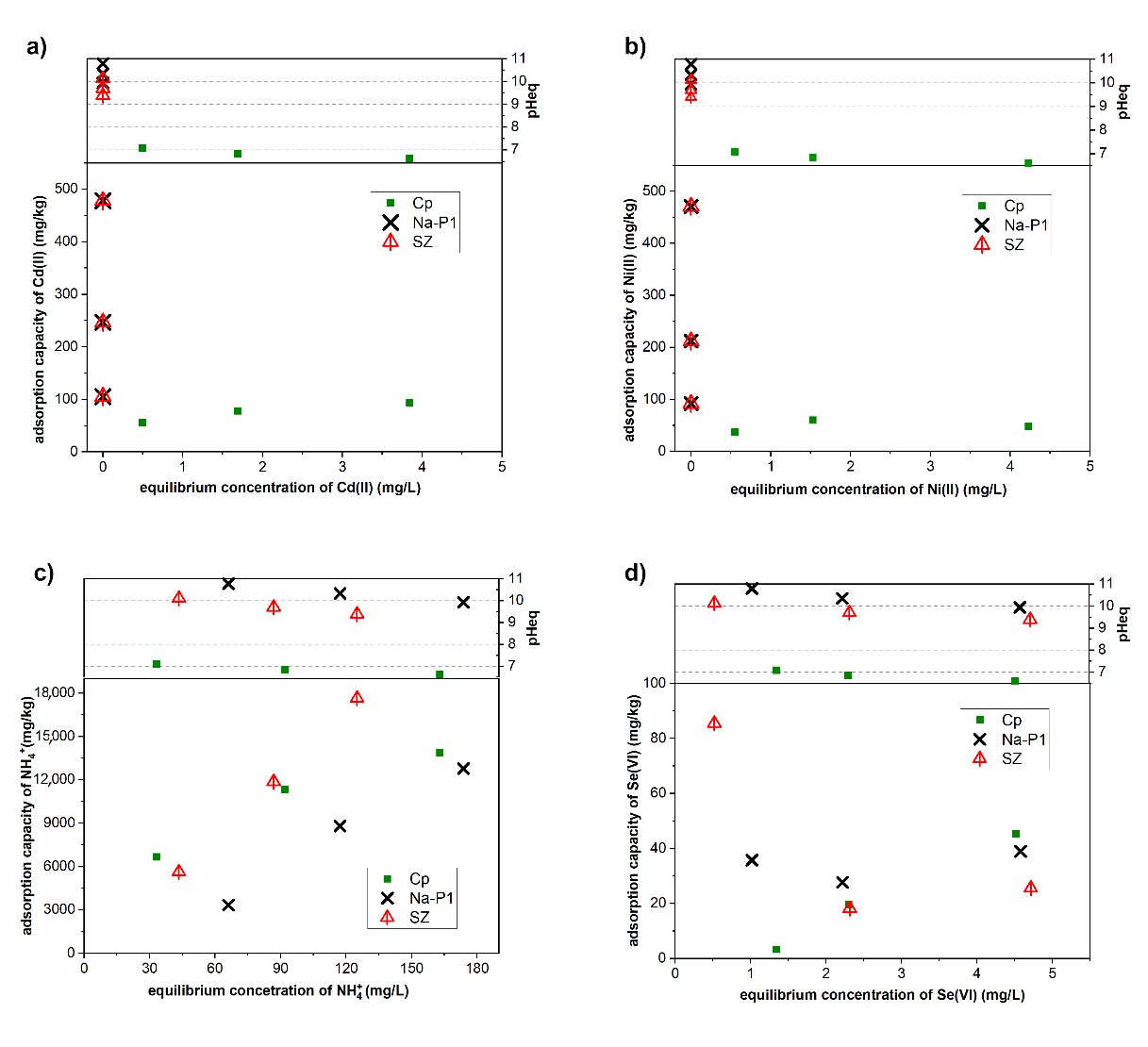
| [wt.%] | SiO2 | TiO2 | Al2O3 | Fe2O3 | CaO | MgO | K2O | Na2O | SO3 | LOI | C |
|---|---|---|---|---|---|---|---|---|---|---|---|
| FA1 | 49.02 | 1.03 | 22.89 | 8.18 | 3.67 | 1.72 | 2.46 | 1.84 | 0.85 | 7.3 | 6.43 |
| FA2 | 45.40 | 1.14 | 27.05 | 6.10 | 2.92 | 2.12 | 3.30 | 0.98 | 0.86 | 8.74 | 6.42 |
| Cp | 70.70 | - | 12.6 | 1.36 | 3.40 | 0.66 | 3.71 | 0.71 | - | 6.34 | - |
| Na-P1 | 32.62 | 1.23 | 30.48 | 4.60 | 3.56 | 1.39 | 0.45 | 8.79 | 0.08 | 16.02 | - |
| SO42− | NO3− | NO2− | NH4+ | Cl− | ||
|---|---|---|---|---|---|---|
| Range | mg/L | 1287–1492 | 0.28–214 | 0.06–0.11 | 294–520 | 7445–8508 |
| Average | 1382 | 120.8 | 0.09 | 393 | 7976 |
| Set 1 | Set 2 | Set 3 | Set 4 | ||
|---|---|---|---|---|---|
| First Stage | CFA + DW | CFA + WW | CFA + 3 M NaOH (DW) | CFA + 3 M NaOH (WW) | |
| Second Stage | First Round | CFA + 3 M NaOH (DW) | |||
| T = 65 °C, t = 0 h | T = 65 °C, t = 1 h | T = 65 °C, t = 12 h | T = 65 °C, t = 24 h | ||
| Second Round | Room temperature | ||||
| CFA + 3 M NaOH (DW) | CFA + 4 M NaOH (DW) | CFA + 5 M NaOH (DW) | CFA + 6 M NaOH (DW) | ||
| Material | CEC meq/100 g | SBET (m2/g) | ||||
|---|---|---|---|---|---|---|
| Cp | 40.69 | 30.31 | 0.123 | 0.012 | 0.082 | 0.029 |
| Na–P1 | 28.80 | 74.91 | 0.225 | 0.030 | 0.161 | 0.034 |
| SZ | 25.40 | 36.0 | 0.101 | 0.013 | 0.068 | 0.020 |
Publisher’s Note: MDPI stays neutral with regard to jurisdictional claims in published maps and institutional affiliations. |
© 2021 by the authors. Licensee MDPI, Basel, Switzerland. This article is an open access article distributed under the terms and conditions of the Creative Commons Attribution (CC BY) license (http://creativecommons.org/licenses/by/4.0/).
Share and Cite
Nowak, P.; Muir, B.; Solińska, A.; Franus, M.; Bajda, T. Synthesis and Characterization of Zeolites Produced from Low-Quality Coal Fly Ash and Wet Flue Gas Desulphurization Wastewater. Materials 2021, 14, 1558. https://doi.org/10.3390/ma14061558
Nowak P, Muir B, Solińska A, Franus M, Bajda T. Synthesis and Characterization of Zeolites Produced from Low-Quality Coal Fly Ash and Wet Flue Gas Desulphurization Wastewater. Materials. 2021; 14(6):1558. https://doi.org/10.3390/ma14061558
Chicago/Turabian StyleNowak, Paulina, Barbara Muir, Agnieszka Solińska, Małgorzata Franus, and Tomasz Bajda. 2021. "Synthesis and Characterization of Zeolites Produced from Low-Quality Coal Fly Ash and Wet Flue Gas Desulphurization Wastewater" Materials 14, no. 6: 1558. https://doi.org/10.3390/ma14061558
APA StyleNowak, P., Muir, B., Solińska, A., Franus, M., & Bajda, T. (2021). Synthesis and Characterization of Zeolites Produced from Low-Quality Coal Fly Ash and Wet Flue Gas Desulphurization Wastewater. Materials, 14(6), 1558. https://doi.org/10.3390/ma14061558








